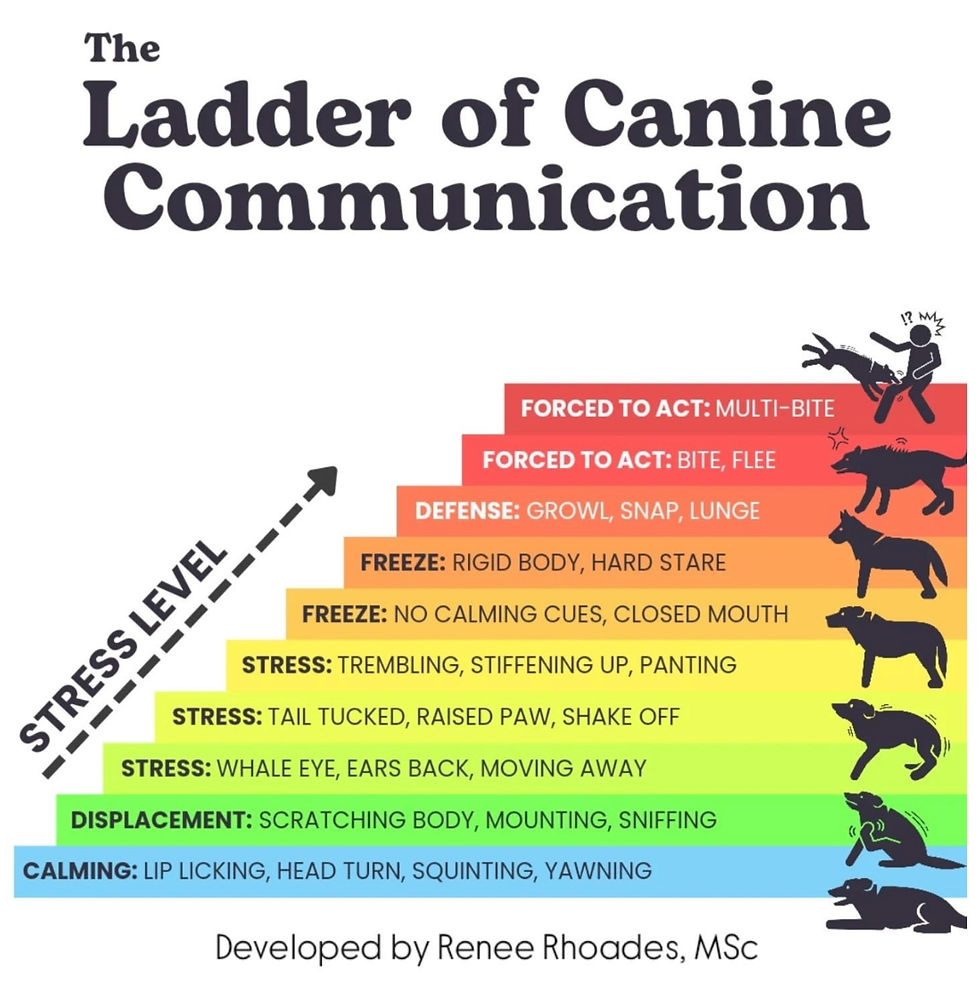Why do dogs bite?
- alice9186
- Apr 28
- 4 min read
As dog lovers, we see our pets as loyal companions and never like to think of them one day having an 'aggressive' side to them. Realistically, every dog has the potential to bite for a multitude of different reasons, and as such, we must treat them as sentient beings who are well within their rights to communicate their opinions with us. Fortunately, most bites are preventable with the right knowledge and behaviour from both pet owners and the public. I have detailed only some of the main reasons below, but this is by no means an exhaustive list.
Fear

A dog might bite out of fear because biting is one of the only ways they know how to protect themselves when they feel threatened or trapped. Like humans, dogs have a natural fight-or-flight instinct. When they’re scared and don’t feel like they can escape, their only option might be to fight and that often means biting. This is especially common if the dog is cornered, on a leash, or confined.
Sometimes people unintentionally scare dogs; by reaching over their head, making direct eye contact, or moving too quickly. If a dog is already anxious, those actions might be interpreted as threatening, prompting a fear-based bite.
Frustration

Dogs might bite out of frustration when they're overwhelmed, excited, or restrained in a situation they can’t control. This type of aggression—sometimes called redirected aggression—happens when a dog can't get to what they want (or escape what they don’t want), so they redirect that pent-up energy or emotion onto the nearest person or animal.
Dogs behind fences, windows, or gates may bark or lunge at people or animals they see. If someone tries to intervene or if the dog is suddenly let out, all that built-up frustration can turn into a bite.
If a dog is constantly told “no” or prevented from doing something without a clear alternative (like being picked up and moved every time they go to the door), they can get frustrated and eventually snap.
When a dog has something that they would like to keep hold of, they may use biting as a way of keeping possession of the item. Resource guarding is a natural behaviour; however often a dog will resort to biting when their low level signs have been ignored and they really want to move that person/dog away from the item. This is more likely to happen if the dog has repeatedly had items taken from them in the past.
Pain

The science suggests around 80% of dogs who display some kind of behaviour problem having underlying pain that contributes towards their behaviour. This could be something they are born with such as hip dysplasia, it could be a muscle strain, an open wound, allergies leading to sore skin or even dental/ear pain. We know full well that if we are in pain, our tolerance reduces, we become snappier, less tactile, less compliant, sometimes more fearful or defensive over part of our body and this is exactly the same in your dogs. Signs your dog might be in pain could include:
Sudden changes in behaviour
Growling or snapping when touched or when entering their space
Limping, shaking, or avoiding movement
Hiding or avoiding interaction
Whining, panting, or pacing without a clear reason
Often, when this has been going on for a while before seeking treatment, it can take a while for the dog to return to normal because they still anticipate discomfort in these situations. This is where further management and support from a professional may be required.
When low-level signals get punished
Sometimes a bite can feel 'out of the blue' because they have never exhibited that level of intense reaction before. Sometimes, this might be true, but more often than not, they offer a load of low-level body language that indicates they are uncomfortable. Identifying these is your warning marker. If these signals get ignored or deliberately punished, then our dog learns that they are ineffective means of communication. When this happens, our dogs can move from very subtle signs to very big responses.

This is why it is so important not to punish our dog's growl, but punishment doesn't just have to be us telling our dogs off. Punishment can be continuing to move our dog towards the thing they don't like eg. walking them towards another dog even though they might be showing signs such as lip licking, head turn away or whale eye. As they get closer to the trigger they work their way up the ladder of communication and realise a certain level works. This then makes them more likely to come in at this level next time they encounter the situation.
Remember that the law within the UK states any person can report a dog if they fear for their safety both in public and within your own home. This means your dog doesn't have to bite someone to be reported and potentially seized. Having a dog at risk of biting doesn't make you a bad owner,
and it doesn't make your dog bad. If you're worried about your dog's behaviour or want some support, get in touch and see how I can help alice@education-4-paws.com





